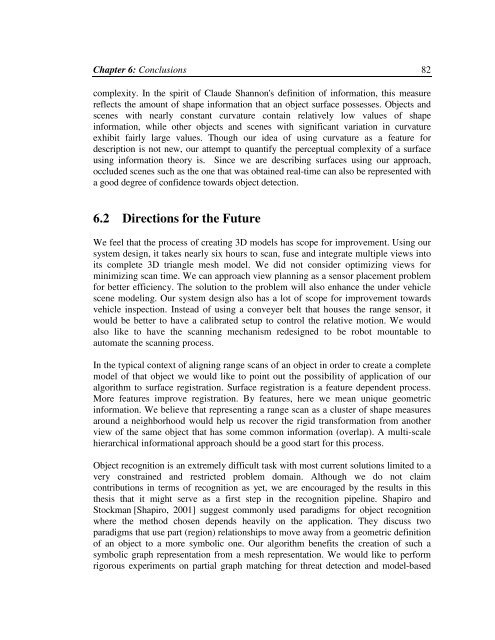To the Graduate Council: I am submitting herewith a thesis written by ...
To the Graduate Council: I am submitting herewith a thesis written by ...
To the Graduate Council: I am submitting herewith a thesis written by ...
Create successful ePaper yourself
Turn your PDF publications into a flip-book with our unique Google optimized e-Paper software.
Chapter 6: Conclusions 82complexity. In <strong>the</strong> spirit of Claude Shannon's definition of information, this measurereflects <strong>the</strong> <strong>am</strong>ount of shape information that an object surface possesses. Objects andscenes with nearly constant curvature contain relatively low values of shapeinformation, while o<strong>the</strong>r objects and scenes with significant variation in curvatureexhibit fairly large values. Though our idea of using curvature as a feature fordescription is not new, our attempt to quantify <strong>the</strong> perceptual complexity of a surfaceusing information <strong>the</strong>ory is. Since we are describing surfaces using our approach,occluded scenes such as <strong>the</strong> one that was obtained real-time can also be represented witha good degree of confidence towards object detection.6.2 Directions for <strong>the</strong> FutureWe feel that <strong>the</strong> process of creating 3D models has scope for improvement. Using oursystem design, it takes nearly six hours to scan, fuse and integrate multiple views intoits complete 3D triangle mesh model. We did not consider optimizing views forminimizing scan time. We can approach view planning as a sensor placement problemfor better efficiency. The solution to <strong>the</strong> problem will also enhance <strong>the</strong> under vehiclescene modeling. Our system design also has a lot of scope for improvement towardsvehicle inspection. Instead of using a conveyer belt that houses <strong>the</strong> range sensor, itwould be better to have a calibrated setup to control <strong>the</strong> relative motion. We wouldalso like to have <strong>the</strong> scanning mechanism redesigned to be robot mountable toautomate <strong>the</strong> scanning process.In <strong>the</strong> typical context of aligning range scans of an object in order to create a completemodel of that object we would like to point out <strong>the</strong> possibility of application of ouralgorithm to surface registration. Surface registration is a feature dependent process.More features improve registration. By features, here we mean unique geometricinformation. We believe that representing a range scan as a cluster of shape measuresaround a neighborhood would help us recover <strong>the</strong> rigid transformation from ano<strong>the</strong>rview of <strong>the</strong> s<strong>am</strong>e object that has some common information (overlap). A multi-scalehierarchical informational approach should be a good start for this process.Object recognition is an extremely difficult task with most current solutions limited to avery constrained and restricted problem domain. Although we do not claimcontributions in terms of recognition as yet, we are encouraged <strong>by</strong> <strong>the</strong> results in this<strong>the</strong>sis that it might serve as a first step in <strong>the</strong> recognition pipeline. Shapiro andStockman [Shapiro, 2001] suggest commonly used paradigms for object recognitionwhere <strong>the</strong> method chosen depends heavily on <strong>the</strong> application. They discuss twoparadigms that use part (region) relationships to move away from a geometric definitionof an object to a more symbolic one. Our algorithm benefits <strong>the</strong> creation of such asymbolic graph representation from a mesh representation. We would like to performrigorous experiments on partial graph matching for threat detection and model-based
















